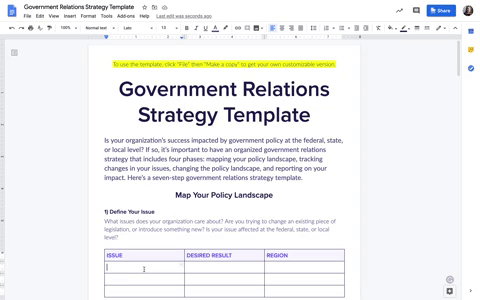1. Define Your Issues
What issues does your organization care about? Are you trying to change an existing piece of legislation, or introduce something new? Is your issue affected at the federal, state, or local level?
2. Identify Your Legislative Champions
Which legislators are most active on your issue? Through a variety of methods, you can figure out which legislators of Congress, state legislators, or city officials are critical to the outcome of the issue your organization cares about. Download the editable template to see a few ways you can identify legislative champions.
3. Build Relationships with Legislative Champions
Once you’ve identified potential legislative champions, you have to build relationships with those legislators and their staff. Surveys from the Congressional Management Foundation have shown that meeting with a legislative office just once is unlikely to have an impact, and it’s important to show the legislator that you are interested in their work and not just seeing them to make an ask. Download the editable template for a checklist of key steps to building relationships with legislative champions.
4. Track Legislation
While you’re building relationships with legislators, you need to be alert to any legislation introduced that affects the issues you care about. First, find a tool that allows you to track legislation. Then, set up a system to organize the legislation your organization is tracking. At times, your organization will likely need to be tracking progress on several pieces of legislation at once, potentially across the federal and state levels, so it’s important to be organized. There are three different ways to visualize your legislative tracking, and an advanced legislative tracking software will let you easily see all three.
5. Communicate Updates to Legislators and Coalition Members
Along with in-person visits to legislators’ offices, it’s important to communicate your organization’s impact through email communication as well. These updates can include events your organization is holding in a legislator’s district, new facilities your organization is opening or new policies your organization has implemented. So as not to overload offices with emails, or go too long without communicating, plan out a schedule of when your team will be sending a message.
6. Integrate Grassroots Advocacy
While your government relations staffers are busy taking meetings with legislators and communicating to stakeholders, a grassroots program can help amplify the voice of your organization to a wider audience. With a well-organized grassroots program, organizations can utilize constituents from a legislator’s district to get their attention, utilize personal relationships, and share stories with legislators.
Best Practice:
Return to step one of this template. Starting with the most critical, make sure you have gone through each of the key steps to making an impact on that issue. Continue to update your plan regularly as legislators in office and your organization’s issue priorities change.




